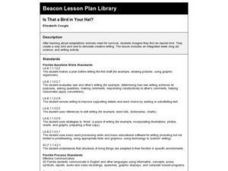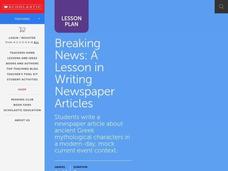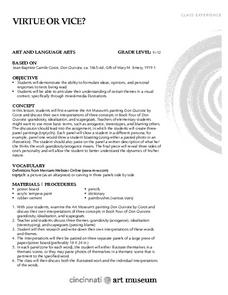Curated OER
Character Attributes in Writing
Third graders analyze the importance of characters in fiction writing and performances. In this theatre lesson, 3rd graders identify the important characteristics of a fictional character and how to portray a character through many...
Walters Art Museum
The Symbolism of Allegorical Art
Introduce learners to allegorical art with four bronze sculptures by Francesco Bertos. After modeling how to recognize bias and allegory in Bertos' Africa, class groups examine the other three sculptures in the series before creating...
Film English
Everyday
What would you do if you got an extra day every week? Partners share some information about their routines and lives and write compositions about one another based on the information. Each partner tries to guess what the other person...
Curated OER
Magical Creatures Land
The opening of J.R.R. Tolkein’s The Hobbit provides a model of how to use rich details to create a setting. After reading the description of Bilbo Baggins’ abode, young writers create their own magical home for a fantasy creature. The...
Curated OER
Shakespeare 2000
Comparing the more modern film Ten Things I Hate About You to The Taming of the Shrew leads to an understanding of how Shakespearean plots can be applied to modern-day situations and characters. As a culminating activity, groups select a...
Curated OER
Is That a Bird in Your Hat?
Second graders imagine they find an injured bird. They create a clay bird and nest to stimulate creative writing. The lesson includes an integrated week-long art, science, and writing activity.
University of Chicago
Using Artifacts for Clues About Identity
Learn about the ancient Near East through a close examination of ancient artifacts. Lead your class into analysis by first observing an artifact as a class. Pupils can then work in pairs to analyze the other artifacts and compile a list...
Curated OER
There's a Monster in My Closet!
Students create their own monsters that exist in their imaginary closets and decorate their environment. They then write a short story to describe their illustration using a prompt.
Curated OER
"Memories of Mom" Memento
Students brainstorm a list of writing topics for a "Memories of Mom" book, choose one of the topics as the subject of a daily essay and combine a week of daily essays into a book to give their mothers for Mother's Day.
Film English
Music
Some emotions are indescribable, but sometimes you have to try! After brainstorming adjectives that describe emotions, pupils watch a quick film, at first with no sound. Partners share their adjectives and come up with descriptions for...
Curated OER
Wynton's Tune
Young scholars examine the serigraph, "Wynton's Tune," by artist Faith Ringgold. They discuss the painting, listen to jazz music, create a drawing that tells a story inspired by their favorite music, and write sentences describing their...
Curated OER
Breaking News
Students organize a newspaper article using a worksheet that helps them study the vocabulary of news articles. They write newspaper articles about mythical creatures invading contemporary Los Angeles.
Curated OER
Communicating Feelings through
Sixth graders use subjects, themes, and symbols to communicate meaning in their own works of art. They describe the origins of specific images and ideas and explain why they are of value in their artwork and in the work of others.
Curated OER
Listen to Grandfather - Say and Write Korean Words
Students create a calligraphy piece using Korean words. They use han'gul script and write with a brush after learning the words. They pay attention to line and space as they create their work of art.
Curated OER
Arthur and His Pals
Arthur, the main character in Marc Brown’s books, is the star of this lesson plan. Pairs of researchers select one character from the Arthur series and use the internet to access Brown’s web site and learn more about their chosen...
Curated OER
Virtue Or Vice?
Students create triptychs, pictures in three panels side by side, of certain themes displayed in the painting "Don Quixote" by Jean-Baptiste Camile Carot. Student evaluations are accomplished through participation during in-class...
Curated OER
Cartoons: How Have Society's Views of Women Changed Over Time?
Students explore women's rights by viewing cartoon images. In this women's history lesson, students view several images depicting women in a certain way while discussing the meaning of the imagery among their classmates. Students write a...
Curated OER
Breaking the Chains: Rising Out of Circumstances
Study history through photographs. In this visual arts and history lesson, high schoolers learn to analyze photographs to discover details about life during the Civil War era. Students write journal entries as if they are the...
Curated OER
My Symbol
Students paint a symbol representing themselves. In this painting lesson students discuss symbols and view the Interpretive Wall. Students write a poem to generate their personal symbol.
Curated OER
Wish Boxes
I love these are lesson ideas! Young artists practice the art of Calligraphy and Origami. They make gift boxes with good wishes. This plan includes an excellent component that shows exactly how to fold the paper in order to make the box,...
Curated OER
Talking About Photographs
Students ask questions and make predictions about photographs that they are shown. In this asking questions and communication lesson plan, students do this with teacher provided photographs and photographs they have brought in themselves.
Curated OER
Seminole Clothing
Students participate in teacher-lead discussion of Seminole patchwork and styles of dress. They practice identifying the patchwork design of the Seminoles and what they mean. They create (and write a description of) a paper doll...
Education World
Monster Mash
Students brainstorm ideas for an original product with the same name, "Monster Mash" and find a unique way to market their invention. They create a prototype of the package in which their product could be sold and focus on marketing...
Curated OER
What Makes a Hero? Characteristics of a Hero
Students define the word hero, choose the personality traits they think make someone a hero, and write about the characteristics they think make a person a hero.























